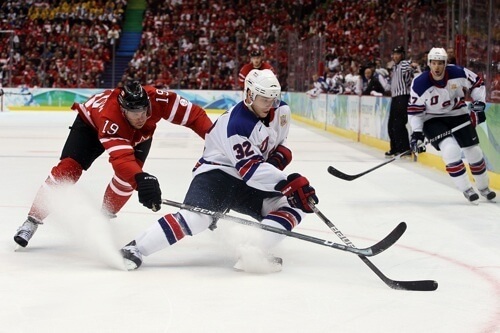What kind of Hockey gear do you typically need?

VIDEO: See this awesome and hilarious Hockey outbreak fight!
Protective gear is one of the most important types. Protective gear helps keep the player safe in what is one of the most intense contact sports in existence. Protective hockey gear starts with a good helmet. The helmet needs to allow free movement and vision, while also providing good protection against all types of hits or falls. Some helmets also have face cages, to keep the face from danger, and additional shields.
• Shin Guards: These are the first piece of equipment to go on. They cover the shins of the players legs to keep them safe from the puck. They are usually labeled left and right, so that you know which one belongs to which leg.
• Socks: These are not your normal socks. These are large socks that go over the shin guards. They are usually matched with the color jersey the player is wearing.
• Pants: The pants are a crucial part of the equipment. They are large in size and protect the player from all forms of danger on the ice. They go on over the shin guards and are filled with padding to help keep the player safe.
• Skates: Without skates, hockey would not be played. The skates need to be put on the right feet and must be tied tight but not too tight that the foot starts to cramp. Every player has their own preference on how tight they like their skates.
• Shoulder Pads: These protect the participant from body checks. They cover both of the shoulders and, depending on length of the shoulder pad, protect a portion of the chest and back. They have great important of safety on the ice.
• Elbow Pads: These protect the elbows and a portion of the forearm. Without this piece of equipment, the player would not last long on the ice.
• Helmet: A must have piece of equipment, the helmet protects the head and face. Today, most people are denied access to the ice surface if they do not have a helmet on. A helmet decreases serious injury dramatically.
• Gloves: The gloves are used to protect the hands. They are made durable enough to protect, yet they are also flexible enough to grip the hockey stick.
• Stick: This is used to give motion to the puck. It is needed to play the game; to pass and shoot.
Chest Protector – If you’re going to get serious about the game, you’ll want to make sure that you get a chest protector that offers padding and support for your chest and shoulders. Make sure you go with great quality so that you are kept safe when you are out there playing.
Mouth Guards – This is one area that you won’t want to skimp on when it comes to ice hockey equipment. Mouth guards do offer great protection to your teeth, which is very important, but they also help to protect your brain as well. Make sure that you have the mouth guard custom made so that it fits you just right, and don’t go cheap when you’re picking out this piece of equipment.
In addition to trying to carve out time for necessary practices, meetings, games and tournaments, one of my biggest challenges is transporting the gear. The hockey gear is really the most challenging, because it’s overall size and bulk. There’s the helmet, skates, socks, breezers, undershirt, chest protection, shin guards, elbow pads and jerseys. There’s also the sticks, water bottles and pucks. On days when both of us play, there’s virtually no room left in the vehicle for the other family members.

